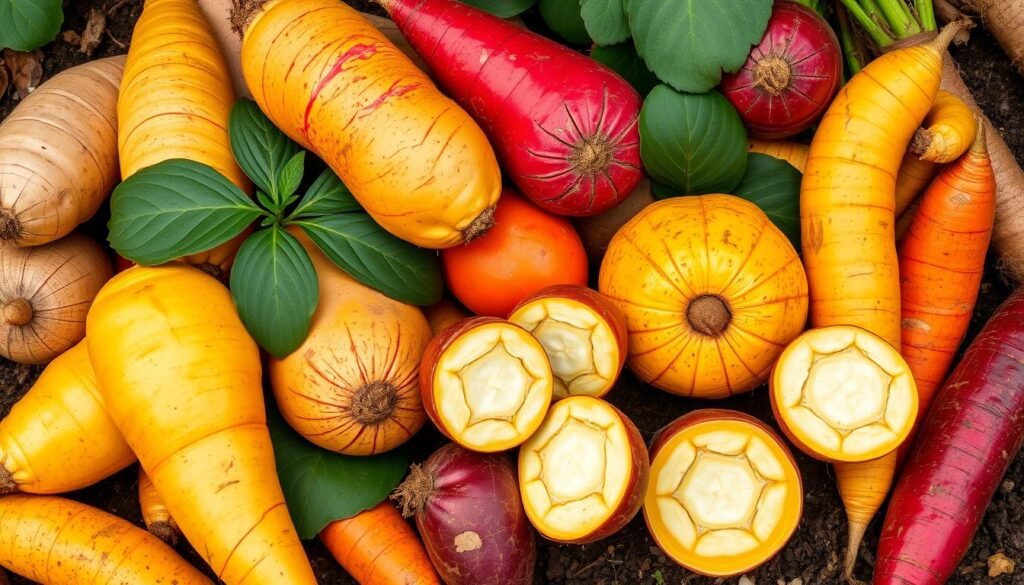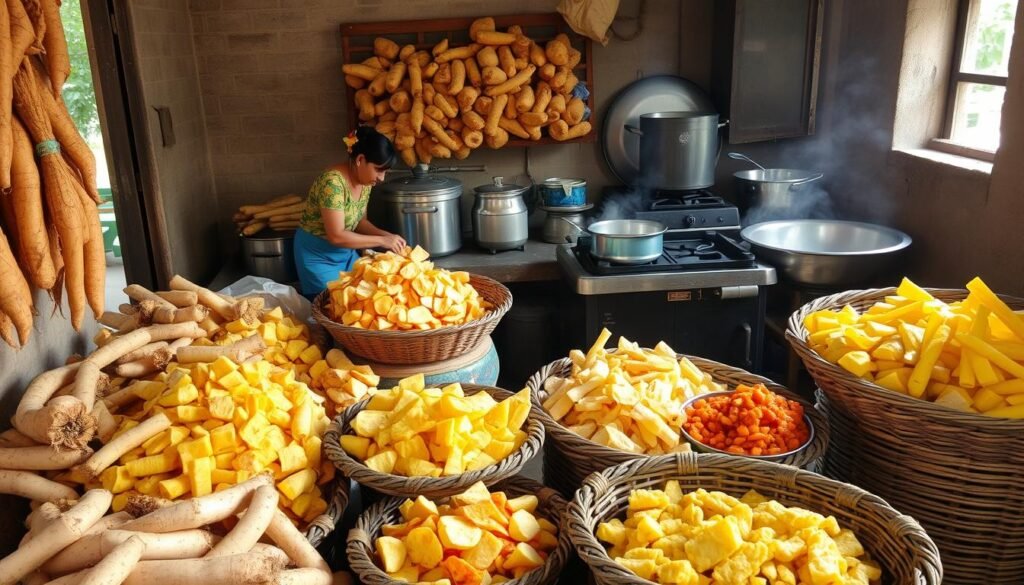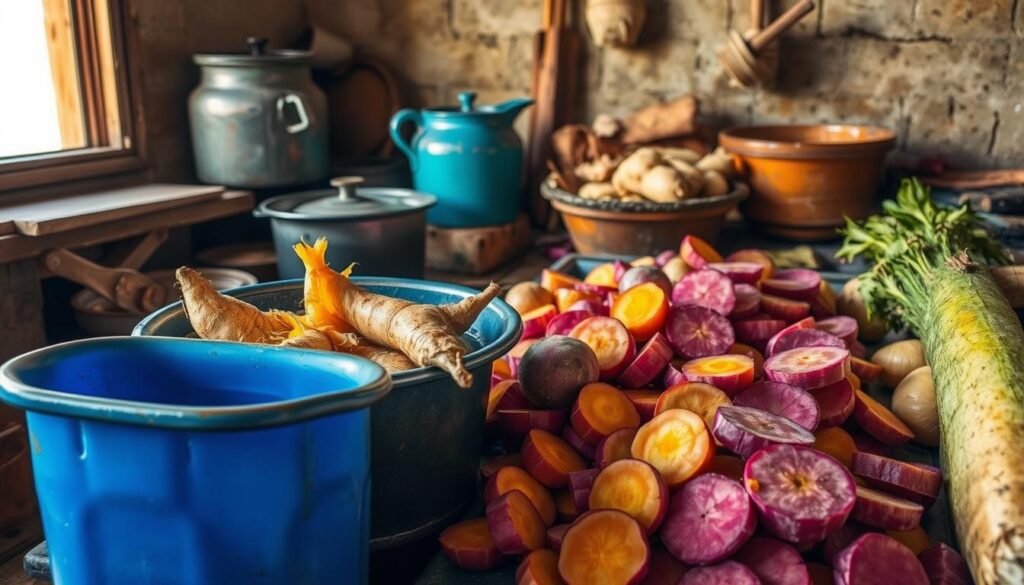Have you ever wondered how a humble tuber like oca yam could change our view of sustainable farming and food safety?
In this article, we start an exciting journey to discover the many uses of oca yam. This nutrient-rich crop is becoming more popular in farming today. It offers new chances through creative processing methods and products. We’ll look at its rich history and health benefits, showing how good oca yam processing can make it more valuable.
We’ll also look at the key processing steps and suggest the best equipment, like the Li An Root Vegetable Washer Peeler. This equipment makes cleaning and preparing oca yam easier. By learning about these important steps, we hope to show how oca yam can help solve today’s food security problems.
Key Takeaways
- Oca yam is a nutrient-dense tuber crop with significant potential for sustainable agriculture.
- Innovative processing techniques can enhance the commercial viability of oca yam.
- Understanding oca yam’s historical significance can inform modern cultivation practices.
- Effective tuber processing equipment, like the Li An washer peeler, is crucial for optimal results.
- Value-added products derived from oca yam can meet growing consumer demand for healthy snacks.
- Addressing food security challenges can be aided by the utilisation of crops like oca yam.
Introduction to Oca Yam
Oca yam, known as Oxalis tuberosa, is a unique tuber crop. It comes from the Andean region, where it was loved by indigenous people. Its colours and tastes add variety to our food, helping our food systems grow.
Oca yam is tough and can grow in tough conditions. This makes it a great choice for sustainable farming. It’s also packed with vitamins and minerals, good for those who care about their health.
As we look for better farming ways, oca yam is key. It can be used in many dishes, leading to new food products. Discovering oca yam shows us the value of plants that are good for us and the planet.
Historical Significance and Nutritional Benefits
Oca yam is deeply rooted in the cooking traditions of indigenous Andean cultures. It has been grown and used for at least 6,000 years. This shows how important oca yam is to communities, providing food and income.
Oca yam is packed with vitamins, minerals, and antioxidants. It’s a favourite in many dishes, boosting health. It helps manage diseases like obesity and diabetes. Its unique compounds also have anti-inflammatory and antimicrobial effects.
Adding oca yam to our meals helps us enjoy its health benefits. It also helps keep cultural traditions alive. By choosing oca yam, we support sustainable food systems and honour traditional farming methods.
Understanding the Varieties of Oca Yam
Oca yam comes in many varieties, each with its own taste, colour, and growth pattern. These traits make them great for different climates and soils. In places like Peru and Bolivia, farmers have grown these varieties for years. They’ve created a wide range of oca yams that are both adaptable and nutritious.
Many things affect which oca yam varieties farmers choose to grow. These include:
- Climatic conditions: Different varieties do well in different weather, helping them survive changes.
- Soil types: Some oca yams like sandy soil, while others prefer clay or nutrient-rich soil.
- Flavour profiles: Each variety has its own taste, from sweet to tangy, making them useful in many dishes.
In the best conditions, a plant can produce up to 50 tubers. Each tuber can grow up to 0.75 kg (1.6 lbs) in weight. It’s important to space plants 90 cm (36 inches) apart to get the most tubers. Harvesting happens from late November to December, after the leaves have frosted. This ensures the tubers are full of water, which is key for their flavour since they can have over 70% water.

Learning about the different oca yam varieties helps us improve food security and biodiversity. Each variety adds to a stronger and more varied agricultural scene. As we learn more about growing oca yams, we see how they connect with our food traditions today.
Oca Yam Processing Techniques
The world of oca yam processing is full of life and change. It shows many ways to make this special root vegetable better and last longer. Techniques like drying, fermenting, and making flour are exciting for cooking.

Drying cuts down moisture, which means oca yam lasts longer and is easier to store. Fermenting adds good bacteria that makes it taste better and is healthier. Making flour lets us use oca yam in many different dishes, making it a hit in food tech.
New tech has made these methods better. Machines now help us work faster and keep quality high. This mix of “food technology” and oca yam processing means we can make top-notch products for more people.
We also care about the planet. We want to make oca yam the best it can be and help the environment. By using green methods, we aim to give healthy food and protect our planet.
Washing and Peeling Machines for Oca Yam Processing
Keeping oca yam processing clean and safe is key. Cleaning the roots well before processing is crucial for food safety and looks. Washing and peeling machines are vital for removing dirt and making oca yam products look better.
Importance of Cleaning in Root Vegetable Processing
Cleaning oca yams right is important for many reasons:
- It removes harmful stuff
- It makes the tubers look better
- It improves the quality and how long they last
- It meets food safety rules
Features of Efficient Washing Machines
When picking washing and peeling machines, look for these key features:
- Adjustable Speeds: Lets you clean based on batch size and soil.
- Soft Brushes: Protects the tubers while cleaning well.
- Water Recycling Systems: Saves water, which is good for the planet.
- Advanced Technology: Boosts cleanliness by up to 90% over old methods.
The Li An series is a top choice for its smart design and efficiency. Washing machines usually clean about 80-90% of root veggies. Peeling yams mechanically can be 30% faster than by hand. Buying this equipment can give a good return on investment, 15-25% a year in farming.
The need for better oca yam products is growing fast, 12% a year. So, picking the right washing and peeling machines is crucial. It helps meet the demand and improve oca yam processing.
Cutting and Slicing Equipment for Oca Yam Products
Processing oca yam involves cutting and slicing, which are key to quality. The right tools can make our products, like chips and flour, better.
Technologies in Slicing for Quality Products
New cutting and slicing tech helps us make more and better products. Machines can handle from 100 to 5000 kg/h. This shows they’re flexible and can keep up with the fast food world.
Automation and efficiency are big now. They help us make oca yam products better.
Highly Processed Oca Yam Products
New tech like vacuum freeze-drying and advanced chopping is exciting. It lets us make unique, healthy snacks. Oca chips are a hit, offering a tasty, healthy snack option.
Innovative Value-Added Products
We’re always looking to make new oca yam products. From gluten-free flours to nutritious flakes, the possibilities are endless. These products add variety to our diets and open up new market chances.
Oca Chips: A Popular Snack Option
Oca chips are loved for their taste and health benefits. We’re working to make them more popular. Cutting and slicing tech will keep us ahead while helping the environment.
The Future of Oca Yam in Sustainable Agriculture
Oca yam is great for sustainable farming. It grows well in many places, helping food systems and security worldwide. Improving our tools shows our dedication to a greener food future.
FAQ
What is oca yam and why is it important?
Oca yam, also known as Oxalis tuberosa, is a nutrient-rich tuber from the Andes. It boosts biodiversity in our food and supports sustainable farming and food security.
What are the nutritional benefits of oca yam?
Oca yam is packed with vitamins, minerals, and antioxidants. It helps keep us healthy. Its phytochemicals fight inflammation and microbes, aiding in managing diseases like obesity and diabetes.
How do we process oca yam?
Processing oca yam involves washing, peeling, cutting, and drying. These steps preserve its nutrients and extend its shelf life, making it more marketable.
What kind of machinery is used for oca yam processing?
Machines like the Li An Root Vegetable Washer Peeler are used for washing and peeling. Cutting and slicing tools ensure the quality and consistency of the final products.
What types of products can be made from oca yam?
Oca yam can be turned into products like chips, flour, and more. These products add variety to our diets and meet the demand for healthy snacks.
Why is thorough cleaning essential in root vegetable processing?
Cleaning is key for food safety and quality. Washing and peeling machines remove dirt and pesticides, making the tubers more appealing.
How does oca yam contribute to sustainable agriculture?
Oca yam thrives in tough conditions, making it a great crop for sustainable farming. Its cultivation boosts food security and preserves cultural heritage, especially in traditional regions.
Source Links
- yam nematode diseases: Topics by Science.gov – https://www.science.gov/topicpages/y/yam nematode diseases
- zein storage protein: Topics by Science.gov – https://www.science.gov/topicpages/z/zein storage protein
- 00 initial pages.p65 – https://cipotato.org/wp-content/uploads/2014/09/1919-Yacon_Syrup.pdf
- Purple Yampee Derivatives and Byproduct Characterization for Food Applications – https://pmc.ncbi.nlm.nih.gov/articles/PMC11675807/
- Root Crops/Yam (Dioscorea spp.) – https://www.appropedia.org/Root_Crops/Yam_(Dioscorea_spp.)
- How to Grow Oca (New Zealand Yams) – https://www.thompson-morgan.com/how-to-grow-oca-new-zealand-yam
- PDF – https://niftem-t.ac.in/pmfme/dpr-tchips.pdf
- Potato Glossary – https://www.tuckertaters.com/Potato Glossary 041421.pdf

